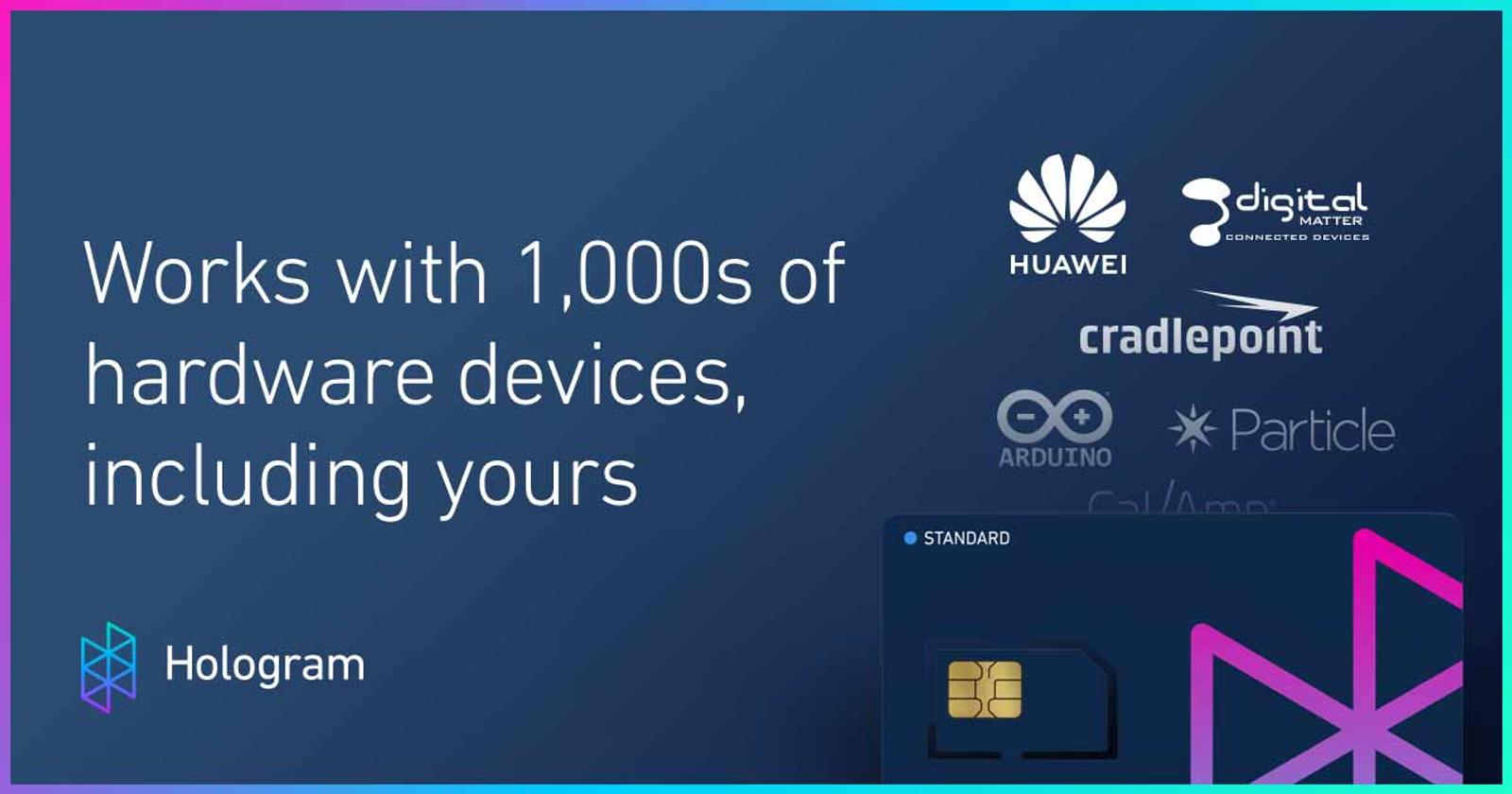Hologram Compatible Hardware

We created a Hologram Compatible Hardware list to showcase the fastest ways to get started on the Hologram network, no hardware knowledge required.
TL; DR: We created a Hologram Compatible Hardware list (/supported-hardware) to showcase the fastest ways to get started on the Hologram network, no hardware knowledge required.At Hologram, connectivity is easier than ever for your cellular connected devices. We've tried to help by publishing a python SDK (/references/python-sdk), creating intuitive hardware like the Nova (/products/nova), and set up simple cellular connectivity plans that prioritize large fleets of IoT devices (/pricing). We're looking to enable even more people by publishing a list of hardware that allows anyone to get started on the Hologram network. Take a look (click image to view full list):
List of hardware
We're calling this the "Hologram Compatible Hardware (/supported-hardware)" list.
Who is this for?
Our goal is to provide options to get started quickly with cellular. If a software developer or entrepreneur wants to start a company tracking assets tomorrow, they might not want to go through a 6+ month hardware design cycle at the outset.Let's create an example. Michelle is an engineer who wants to start a business that tracks food trucks in her city. Her plan is to sell an app that showcases the best food truck locations with live location tracking data. On day one of the company, Michelle chooses an off-the-shelf asset tracker (/blog/what-is-cellular-asset-tracking) from the Hologram Compatible Hardware list, inserts a Hologram SIM card, interfaces with our API, and starts inputting truck data into a 3rd party API like Google Maps (https://developers.google.com/maps/). She gives this hardware to a couple of pilot program trucks and starts sending data to her app. A few months down the road, Michelle decides to implement some more data heavy tasks in the trucks (grill temperature, average wait time, weather conditions). She decides to test a custom platform using the Hologram Nova (/products/nova) and a Raspberry Pi while still collecting data from trucks with the first version of hardware out in the field. After a month of testing, Michelle decides to build her own device in order to stave off competition from other apps employing a similar solution. She uses the open source plans from the Nova (/guides/open-sourced-hardware) and enlists a contract manufacturer to build a much more customized solution for her growing food truck tracking empire. In this example, Michelle's business grows from day one, while testing and customizing hardware for tomorrow.
How fast can you get started?
We've include a “steps to market” field in this list. We're hoping this helps to visualize the ease of integration in your potential business. Here's a short description of each.
- Finished Goods, no hardware knowledge required. Just buy and insert a Hologram SIM card (/products/iot-sim-card), follow our 3rd party hardware integration steps (/blog/connecting-3rd-party-hardware-to-the-hologram-network), and you're ready to transmit data.
- Need to be integrated into final product, either with repackaging or rebranding. Using items at this level may require certification on cellular networks.
- Needs to be re-worked into a product, cannot be integrated into a final product without PCB work. Will require certification on multiple levels.
A simple way to view this list is by the type of contract labor a beginner would need to hire. Level 1 probably requires a software engineer to get started, level 2 requires a mechanical engineer or designer to integrate or relabel the hardware (and a software engineer) and a level 3 requires an electrical engineer, a mechanical engineer and a software engineer. It's likely only the 3rd level will require manufacturing capabilities.
"Hologram Compatible" requirements
You might be left wondering why a particular piece of hardware is not on this list. More to the point, how will we determine what is "Hologram Compatible"?First, we wanted to find hardware that will get our customers started quickly, across a range of different product categories. This includes areas like asset tracking and fleet monitoring, industrial gateways, phones, tablets, and even bike sharing. These are all fields where we have seen Hologram perform very well and we expect to see more customers in the near future. They are also products that are end-user focused. Our friend Michelle from a few paragraphs ago can buy these white label devices, insert a SIM and start streaming data to her app. For people that are more ambitious from day one, they can start creating custom hardware with embedded boards or add-on modules. We understand that many users are interested in data today and plan to figure out the hardware in the long term.To summarize, the following is needed to get onto our lists:
- Hardware that can be purchased by an end user and integrated into a "whitelabel" situation.
- An accessible SIM card slot, so that users can insert a Hologram SIM.
- (Variable timeline) Tested on our network.
The future
This is a living document and we'll continue to add more hardware as we test it on our network and as we hear about new hardware entering the market. We're very excited about all of the LTE Cat M1 (https://en.wikipedia.org/wiki/Narrowband_IoT) hardware that is entering the market right now. This will accelerate as 2G towers continue to sunset throughout the world (/blog/future-proofing-your-iot-networks-lessons-from-the-2g-shutdown).
If you have hardware on-hand you'd like us to evaluate, please let us know! You can post about it on our forum (https://community.hologram.io) or you can email us (mailto:success@hologram.io).